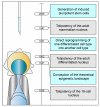Development-inspired reprogramming of the mammalian central nervous system
- PMID: 24482482
- PMCID: PMC4122114
- DOI: 10.1126/science.1239882
Development-inspired reprogramming of the mammalian central nervous system
Abstract
In 2012, John Gurdon and Shinya Yamanaka shared the Nobel Prize for the demonstration that the identity of differentiated cells is not irreversibly determined but can be changed back to a pluripotent state under appropriate instructive signals. The principle that differentiated cells can revert to an embryonic state and even be converted directly from one cell type into another not only turns fundamental principles of development on their heads but also has profound implications for regenerative medicine. Replacement of diseased tissue with newly reprogrammed cells and modeling of human disease are concrete opportunities. Here, we focus on the central nervous system to consider whether and how reprogramming of cell identity may affect regeneration and modeling of a system historically considered immutable and hardwired.
Figures




References
-
- Gurdon J. From nuclear transfer to nuclear reprogramming: the reversal of cell differentiation. Annual review of cell and developmental biology. 2006;22:1. - PubMed
-
- Gurdon J. Adult frogs derived from the nuclei of single somatic cells. Developmental biology. 1962;4:256. - PubMed
-
- Gurdon J, Uehlinger V. “Fertile” intestine nuclei. Nature. 1966;210:1240. - PubMed
-
- Hochedlinger K, Jaenisch R. Nuclear reprogramming and pluripotency. Nature. 2006;441:1061. - PubMed
Publication types
MeSH terms
Substances
Grants and funding
LinkOut - more resources
Full Text Sources
Other Literature Sources

